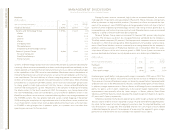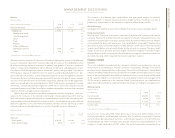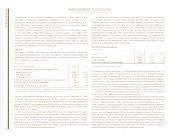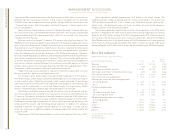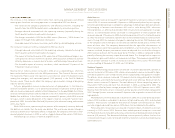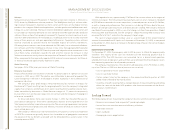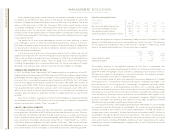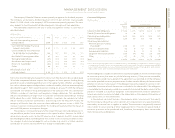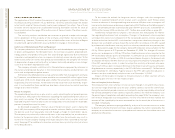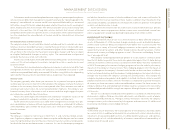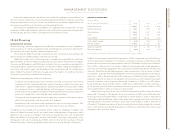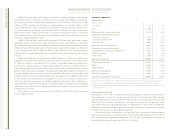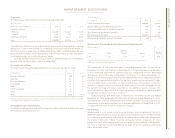IBM 2004 Annual Report Download - page 33
Download and view the complete annual report
Please find page 33 of the 2004 IBM annual report below. You can navigate through the pages in the report by either clicking on the pages listed below, or by using the keyword search tool below to find specific information within the annual report.
MANAGEMENT DISCUSSION
International Business Machines Corporation and Subsidiary Companies
31
ibm annual report 2004
The company’s Board of Directors meets quarterly to approve the dividend payment.
The company announced a dividend payment of $0.18 per common share, payable
March 10, 2005, which is the company’s 357th consecutive quarterly payment. The com-
pany expects to fund the quarterly dividend payments through cash from operations.
The table below represents the way in which management reviews its cash flow as
described above.
(Dollars in billions)
FOR THE YEAR ENDED DECEMBER 31: 2004 2003 2002 2001 2000
Net cash from operating activities
(comprised of): $«15.4 $«14.6 $«13.8 $«14.0 $««8.8
Cash from/(for) Global Financing
accounts receivable $«««2.5 $«««1.9 $«««3.3 $«««2.0 $«(2.5)
Cash available for investment and
for distribution to shareholders 12.9 12.7 10.5 12.0 11.3
Net Global Financing receivables 0.7 (0.7) 0.2 0.9 (0.6)
Net capital expenditures (3.7) (3.9) (4.6) (4.9) (4.3)
Net divestitures/(acquisitions) (1.7) (1.7) (2.0) (0.9) (0.3)
Returns to shareholders (8.3) (5.4) (5.2) (6.5) (7.6)
Other 2.9 0.9 0.2 2.2 —
Net change in cash and
cash equivalents $«««2.8 $«««1.9 $««(0.9) $«««2.8 $«(1.5)
Events that could temporarily change the historical cash flow dynamics discussed on page
30 include unexpected adverse impacts from litigation or future pension funding during
periods of severe and prolonged downturn in the capital markets. Whether any litigation
has such an adverse impact will depend on a number of variables, which are more completely
described on page 71. With respect to pension funding, on January 19, 2005 the company
contributed $1.7 billion to the qualified portion of the company’s PPP. This contribution
fulfilled a number of short-term and long-term strategic objectives. This contribution
reduces the probability of large future U.S. pension contributions by building a funding
buffer above the current liability level. In addition, it positions the company to further
reduce volatility in pension contributions and earnings over the long term. Finally, the
company will benefit from the return on these additional pension assets in 2005. The
increase in pension income produced from this funding will partially offset the impact of
year-end 2004 pension assumptions changes.
The company is not quantifying any further impact from pension funding because it is
not possible to predict future movements in the capital markets. However, for 2005, if
actual returns on plan assets for the PPP were less than 1 percent, the PPP’s accumulated
benefit obligation (ABO) would be greater than its Plan assets (assuming no other assump-
tion change). As discussed on page 83, such a situation may result in a further voluntary
contribution of cash or stock to the PPP or a charge to stockholders’ equity.
Contractual Obligations
(Dollars in millions)
Total
Contractual
Payment
Payments Due In
Stream 2005 2006-07 2008-09 After 2009
Long-term debt obligations $«17,664 $«3,175 $«4,396 $«2,614 $÷«7,479
Capital (Finance) lease obligations 56 46 8 1 1
Operating lease obligations 6,607 1,383 2,210 1,603 1,411
Purchase obligations 2,268 919 828 479 42
Other long-term liabilities:
Minimum pension funding
(mandated)*2,384 361 1,175 848 —
Executive compensation 782 95 121 141 425
Environmental liabilities 246282523170
Long-term termination benefits 2,406 344 483 334 1,245
Other 457 80 166 136 75
Total $«32,870 $«6,431 $«9,412 $«6,179 $«10,848
*These amounts represent future pension contributions that are mandated by local regulations or statute for retirees
receiving pension benefits. They are all associated with non-U.S. pension plans. The projected payments beyond 2009
are not currently determinable. See note w, “Retirement-related Benefits,” on pages 78 through 86 for additional infor-
mation on the non-U.S. plans’ investment strategies and expected contributions.
Purchase obligations include all commitments to purchase goods or services of either a fixed
or minimum quantity that meet any of the following criteria: (1) they are non-cancelable,
(2) the company would incur a penalty if the agreement was canceled, or (3) the company
must make specified minimum payments even if it does not take delivery of the contracted
products or services (“take-or-pay”). If the obligation to purchase goods or services is non-
cancelable, the entire value of the contract is included in the above table. If the obligation
is cancelable, but the company would incur a penalty if canceled, the dollar amount of the
penalty is included as a purchase obligation. Contracted minimum amounts specified in
take-or-pay contracts are also included in the above table as they represent the portion of
each contract that is a firm commitment.
In the ordinary course of business, the company enters into contracts that specify
that the company will purchase all or a portion of its requirements of a specific product,
commodity, or service from a supplier or vendor. These contracts are generally entered
into in order to secure pricing or other negotiated terms. They do not specify fixed or
minimum quantities to be purchased and, therefore, the company does not consider
them to be purchase obligations.



